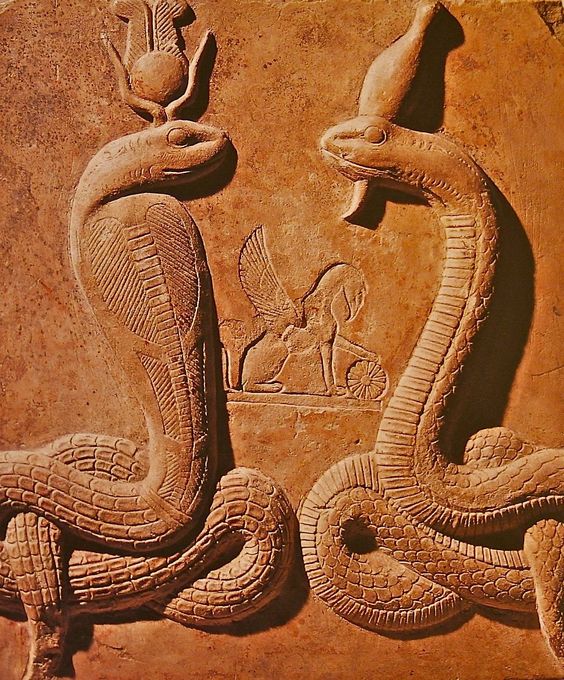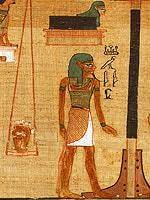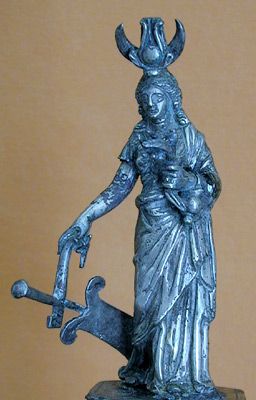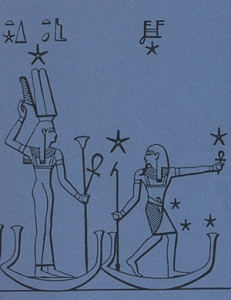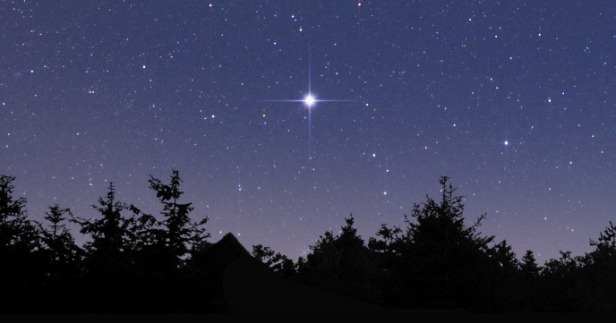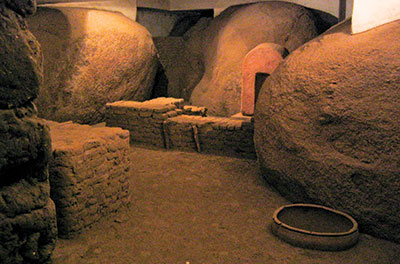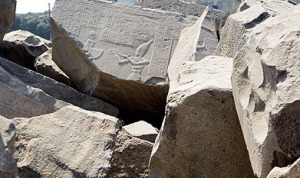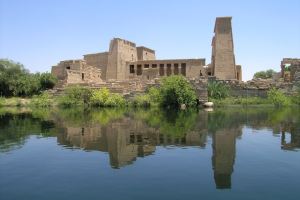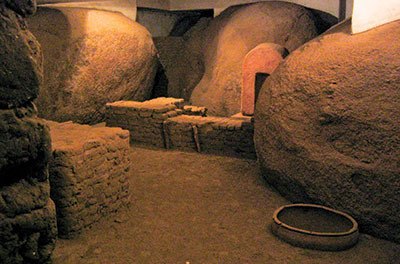One thing I learned from our Egyptian visit to the Great Temple of Hathor at Denderah, is just how very, very, very present Isis is in this entire temple complex.
I knew that, just as Hathor has a small temple at Isis’ great Philae sanctuary, so Isis had a small temple at Hathor’s great sanctuary at Denderah. But I didn’t know how present Isis is within Hathor’s temple itself.
So, today I’d like to share with you some of the praises and epithets of Isis found within the great Hathor temple. They can be used and/or adapted through your own creativity for ritual use. The translations come from Egyptologist Sylvie Cauville’s Dendara: Hymnes à Hathor et à Isis. So they are my English translations (with help from Google Translate) of her French translations of the hieroglyphs. I’m awaiting an interlibrary loan of her book on all the texts from Isis’ small temple at Denderah. I’ll share those with you in the future.
But for today, let’s look at some of the ways Isis was understood at Denderah. Since most of the remains at Denderah are Ptolemaic, we won’t be surprised to find Isis expressing Herself there in many of Her ten thousand names. Here’s an example:
Isis the Great, Mother of the God, Mistress of the Birth Mound, Who takes Her place in Denderah, Lady of the Beginning of the Year, Queen of Messengers, Who appears at the New Year to open the Beautiful Year. [She is] Amunet (the Goddess counterpart of Amun) at Thebes, Menhit (a Lioness Goddess) in Heliopolis, Renpet (“Year”) is Your name in Memphis, Sothis (Sopdet, the Star Goddess) in Elephantine, Hededyt (a Scorpion Goddess) in Edfu, the Venerable Vulture (the Goddess Nekhbet), the ruler of Hierakonpolis (Nekhen), the Feminine Heliopolitan One in Denderah, Daughter of Nuet, brought into the world in the Birth Mound on the beautiful day of the Child-in-His-Nest, the One Who takes flight again towards the sky; Heqet (the Frog Goddess) in Abydos, Seshat (the Scribe Goddess) in Hermopolis, Djedet (“Word” or “Great Word,” Djedet Weret) is Your name in Busiris, the Mysterious One in Bubastis, Ipyt (a Hippopotamus Fertility Goddess) in Pe, Depet (“the One of Dep”) in Dep, Neith in Sais, Wadjet in Nebecheh (the location of a temple of Wadjet), Hathor in all the land. She is the One Who dwells in every city and in every nome with Her son Horus and Her brother Osiris.
Those of you who have seen the Oxyrhynchus aretalogy of Isis will recognize this format: give Her name and then the place in which She is called by that name (or vice versa).
On one of the pylon doorways at Denderah, where both Goddesses are invoked, we learn this of Isis’ power:
She is the Sovereign of the Palace, the Ruler, the Mistress of Writing. She announces what will happen in the future. Life is in Her hand, health is in Her fist, one does not oppose what comes from Her mouth. She takes care of the one who is not unfaithful to Her and defends the one She loves on the day of the “fight in the arena” (I assume this means during challenging times; but I supposed it could be something more specific, too). She is the irreproachable protector of those who have nothing and those who have everything. What She conceives happens forever. She comforts the unfortunate with Her word at the closing gate. She is Seshat the Great, the Primordial, the First Who Inaugurated Writing, the First Who is Brought into the World Among the Goddesses.
On the doors of the “Mysterious Corridor,” Isis is praised as the Powerful One. Re is said to shine in the horizon (akhet) when He sees Her and human beings come to Her to make Her heart joyful. In the Isis Chapel within the Hathor temple, She is called by many of the titles we have already seen, but She is also the Queen of Egypt in its Entirety, the Great One in Heaven, the Powerful One on Earth, the Primordial One Who Created the First Time (Zep Tepi) and All Good Things—which She shares with those She loves. She “dispenses the Commandments in the places of worship.” What must happen “happens when You [Isis] order it.” She is “excellent and beautiful.” She is “the Female Ibis Without Her Equal, the Mistress of Writing, the Sovereign of the Library.” She is the ruler of the orb of the sun and of the stars. As Sothis, She is the One Who Brings the Flood to “create life for the living.” She is the Eye of Re and the Unique Uraeus serpent.

She is also called Horet, the Female Horus. Her favors to Her devotees are great as is Her love. She is the Hand of God with inexhaustible benevolence. And Her true name is Isis (but also The Golden). This is very reminiscent of Apuleius’ aretalogy of Isis in which the Goddess lists many of the names by which human beings know Her, but finally states that Her true name is Queen Isis.
Quite a few of the Isiac hymns in the Denderah temple repeat many of the epithets we’ve already seen, so I’m trying to pick out the ones I find interesting and that I think you may also find interesting.
For instance, epithets from the Denderah Chapel of Water and Chapel of the Crown call Isis the Great Oracle Who Arrived at the Beginning and the Oracle Who Announces What Will Happen in the Future. These would be perfect epithets to use when reading Tarot or using another divination system under Her auspices. The Chapel of Water also says that She makes the Inundation flow to “invigorate the hearts of the Guardian Gods;” so another protective function. Her Ka is praised and She is called the Living Ba. She is the Lady of East, South, West, and North.
In the Chamber of Fabrics, Isis is identified with Tayet, the Weaving Goddess. The text says that the Divine Fabric is made for Her Ka and that She is Mistress of the White, Green, Purple/Blue, and Red fabrics.
One of the things especially celebrated at Denderah is the birth of Isis. Her birth is connected to the epagomenal days when She rises as Sirius before the sun to mark the New Year.
In the Chapel of the Sistrum, it is said that Isis “took possession of the royal office even before She left the womb; She ruled the throne from Her swaddling clothes.” I’m guessing we’ll learn more about Her birth when I get that interlibrary loan of the texts from the small Temple of Isis.
On the exterior temple walls, Isis is said to be born “in the form of a black-haired woman, full of life, Sovereign of the Ennead, Ruler of Magic.” More of Her ten thousand names are added in the pronaos of the temple: She is Amunet, Menhit, Renpet, Sothis, Nekhbet, Tanenet (a Goddess of brewing and childbirth), Isis, Seshat, Heqet, and Wadjet. She is also the One Who Loves the Embrace, the Mistress of Life, Tayet, She Who Hears Everything, the Mysterious, Pyt (possibly a variation or misspelling of Ipyt), Depet, Neith, Khensyt (a Goddess of the royal crown), and Isis in every nome. She is the Mistress of Offerings, the Feminine Disk (of the sun), Mistress of Bread, Who Prepares Beer, and Lady of Exultation and Joy. She is the One Who is Rejuvenated in the Faiyum, Mistress of Life in Metenou (couldn’t find out where that is). In Mendes, She is the One Who Speaks. In Busiris, She is the One Who Hears Everything. And She is still The Mysterious in Bubastis.
The pronaos also notes that on the birthday of Isis, joy breaks out in Denderah and in Edfu. (Remember that these two temples are connected by the love connection between Hathor and Horus.) Heavenly Nuet gives birth to Isis—the Scholar for the Ennead—so that She may give birth to Horus the Avenger. The text says that Isis “was initiated into Wisdom as the Great One” and that the Goddesses come to see Her birth, wearing the menat-necklace and bearing the sistrum, “to appease the heart of The Magician (that is, Isis).”
That’s a lot of (hopefully) new and interesting epithets to work with for today. Any one of these epithets of Isis or Her identifications with other Goddesses would be a worthy subject for invocation and meditation.










